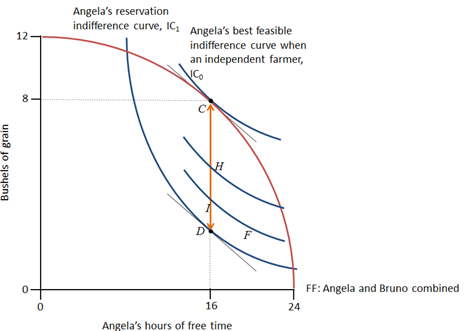1.8) Consider the diagram below. Legislation allows Angela, a farmer, to be at point F. (SEE ATTACHED PICTURE) If Angela, a farmer, and Bruno, her landlord, can bargain costlessly: Select one or more: a. The final outcome will be unchanged. b. The final outcome will be a Pareto improvement. c. The final outcome could be anywhere on the "contract curve" of Pareto-efficient points between C and D. d. The final outcome will be somewhere between (or at) points C and I.
Please tell me which of the multiple choices are correct in question 1.8)1.9)1.10) just state the correct ones please thank you please bear in mind they are separate questions and not related to each other so awnser each individually as there is no link between them the diagram which is needed for solving question 1.8 only, is attached.Other two questions don't have a diagram they are just multiple choice questions
1.8)
Consider the diagram below. Legislation allows Angela, a farmer, to be at point F.
(SEE ATTACHED PICTURE)
If Angela, a farmer, and Bruno, her landlord, can bargain costlessly:
Imagine the
| Linear scale: an upward-sloping curve with increasing slope (called convex shape) | Ratio scale: an upward-sloping straight line |
| Linear scale: an upward-sloping straight line | Ratio scale: a straight horizontal line |
| Linear scale: an upward-sloping straight line | Ratio scale: an upward-sloping curve with decreasing slope (called concave shape) |
| Linear scale: an upward-sloping convex curve | Ratio scale: an upward-sloping convex curve |

Step by step
Solved in 2 steps






